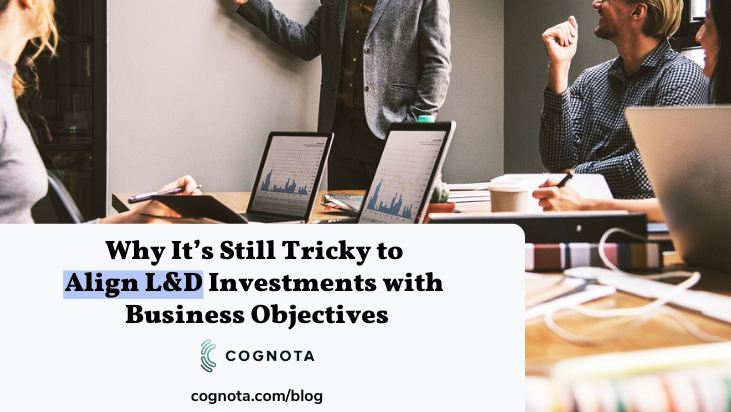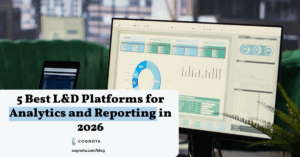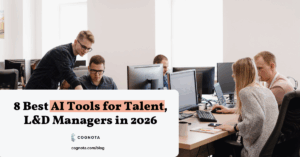On Tuesday, June 25, Cognota hosted a webinar, The Alignment Conversation: Strategies to Align L&D Investments to Business Objectives, that explored how to more strongly integrate L&D into the business framework in order to elevate educational outcomes, drive dynamic growth, and maximize ROI.
Cognota founder and CEO Ryan Austin was joined by Bob Mosher, CEO and Chief Learning Evangelist of APPLY Synergies; Siv Jambunathan, Director of Supply Chain Learning and Development at General Mills; and Kevin M. Yates, Impact Investigator at L&D Detective.
Austin kicked off the event by providing insights and demonstrating the business results when organizations begin operationalizing corporate training initiatives. By adopting a methodology of learning operations, or LearnOps, people, best practices, processes, and technology all work together seamlessly for enhanced oversight, faster development cycles, and higher impact.
Instead of relying on a single tool to handle a business process, companies should work smarter, not harder; by removing siloes and having more collaboration with business partners, they can benefit from better oversight of their learning investments.
Austin continued to discuss why LearnOps can often be difficult to implement for organizations unused to the methodology. They need to be made aware that there is a roadmap or maturity model, as organizations begin to understand the role and impact that learning can have on the business.
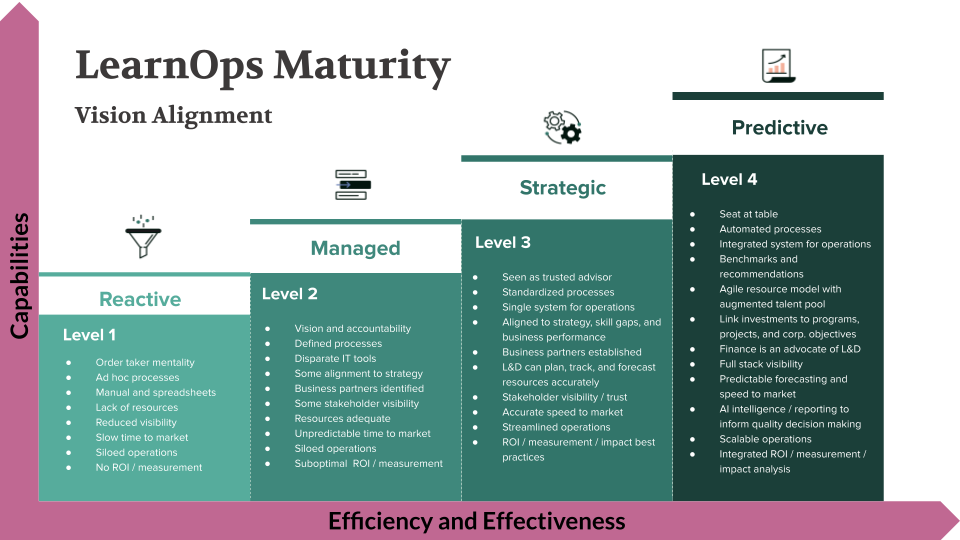
Starting at the Reactive, Level 1, learning teams are simply trying to push out training content with little to no regard for ROI or measurement. Moving to Level 2, L&D starts to incorporate accountability and stakeholder visibility, but the ROI is still suboptimal. By Level 3, Strategic, learning operations have started to become standardized and streamlined, and by Level 4, Predictive, senior management trusts the learning team to deliver results based on automated processes and predictable forecasting.
Alignment and frameworks
Siv Jambunathan, Director of Supply Chain Learning and Development at General Mills, then took the floor to provide some additional insights. He shared how General Mills has shifted from improving learner experience to improving both learner performance and experience.
Jambunathan proceeded to explain how his L&D teams a few quarters back started to align their learning strategy with the enterprise business strategy. They asked questions about the business’ growth, margins, and focus areas, as a way to drive conversations about the specific talent and functional skill development required to map to those business needs.
This broader context is provided by a dedicated team of leaders across the organization and identified by the CHRO, in order to fully understand the business’ priorities.
For efficiency and access to shared resources, Jambunathan explained General Mills’ creation of an internal Learning Leader Council, to advise on LMS technology and tech stack to deliver the required learning.
Aligning for design
Bob Mosher, CEO and Chief Learning Evangelist of APPLY Synergies, then took the floor to discuss how we need to get out of the “new and more” business—meaning, learning efficiency shouldn’t simply be about finding ways to create more content.
Instead of a content pivot, Mosher explained the need for a context pivot. Learners are less interested in “content is king” and instead are more interested in learning concepts that align more with their jobs and their relevance to the overall business.
Likewise, L&D professionals do not want to be seen as order takers; instead, they want to be seen as strategic partners that impact KPIs. Learning leaders should be prepared to answer questions about business problems to solve directly from the business itself.
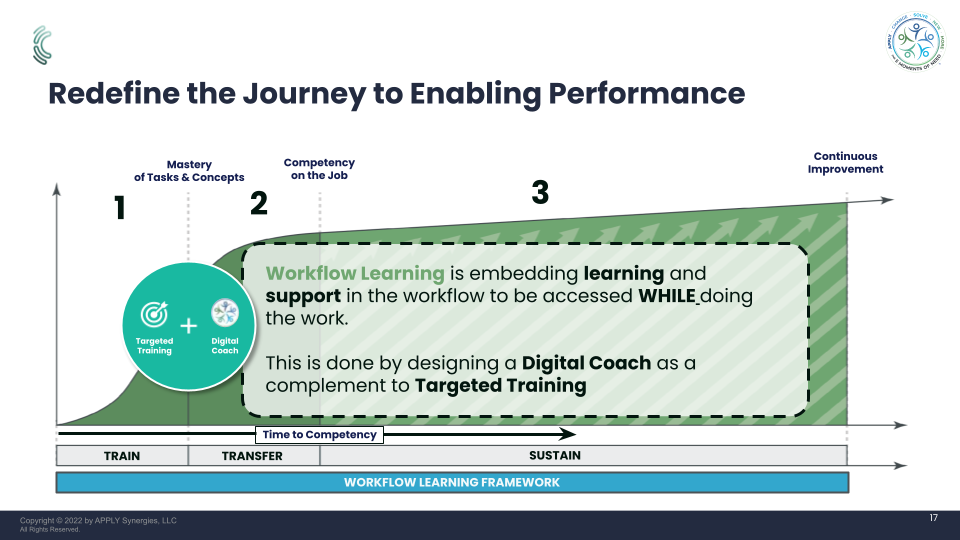
Impact on workplace performance
Finally, Kevin Yates, Impact Investigator at L&D Detective, took the floor to further discuss L&D alignment and its impact on workplace performance and results.
“If you do not align and plan for impact in the beginning—before any learning is developed and learners participate—measuring impact will be difficult if not impossible in the end,” cautioned Yates.
Workplace performance is human performance and business performance, Yates points out, and shared with the audience the nine questions he uses to gain insight into the performance needs of the organization:
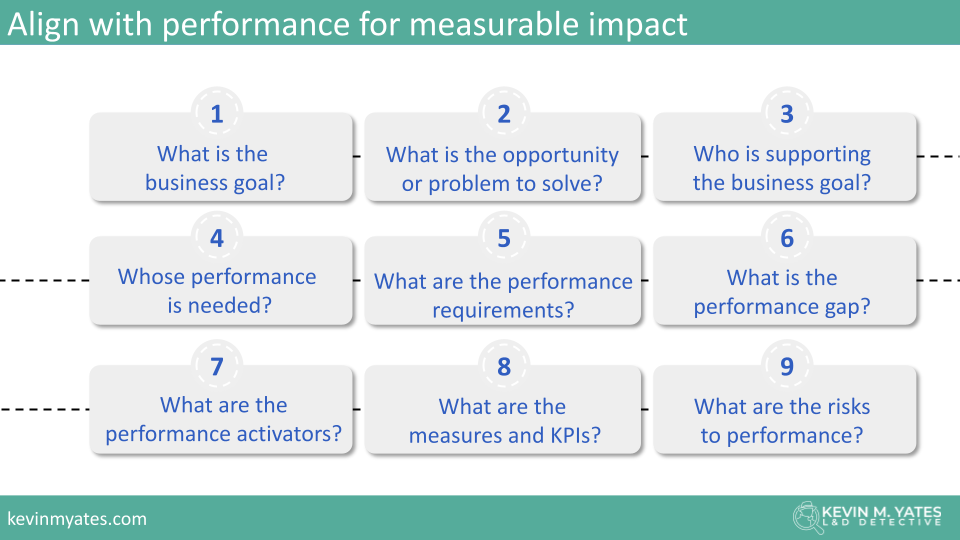
Yates explains how the data obtained from the LMS and surveys is limited. Unfortunately, that data is of little importance to business managers and senior leadership, who have a set of metrics that are important to them. The faster L&D can speak the same language and track the same KPIs as the business, the closer the impact of L&D will be.
Combining it all for outsized results
With a learning operations or LearnOps strategy in place, data, analytics, and insights are accessible to all who engage with the learning function—from designers to subject matter experts to business unit leaders.
As the first and only operations platform built specifically for L&D teams, Cognota’s LearnOps platform brings the entire learning workflow into one platform. In addition to saving time and realizing cost efficiencies, learning leaders get auto-generated insights into the performance of their teams and the learning needs of their entire organization. By leveraging a LearnOps platform, organizations can access diverse tools and methodologies to tackle today’s complex challenges.
Get started with a free LearnOps consultation. Book a demo today!
If you’d like to hear the expert’s opinions in full, check out the on-demand recording of the webinar here.
